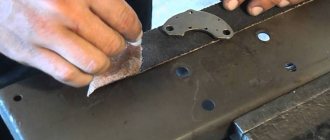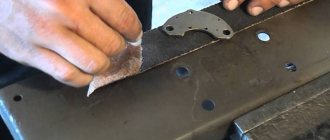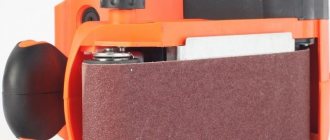First you need to understand what a grinder is and what it is used for. A grinder is a machine for grinding various materials, the choice of which directly depends on the belt used for grinding.
Grinder tape catalog
As a rule, special grinding machines are used in production for processing materials, but the disadvantage of such equipment is its high cost and often quite expensive maintenance, which in turn makes it impossible to use this type of machines in small and home workshops. As a rule, small homemade machines called grinders are used in home workshops to process various materials. Each master makes these belt grinding machines on his own and for personal needs, focusing on his own needs in processing materials, therefore such mechanisms differ from each other in various indicators - speed of operation, length and width of the belt, dimensions of the machine and its purpose. This state of affairs creates difficulties in selecting the size of belts for the grinder, if the machine was made independently. Of course, there are industrial grinders that are used in enterprises and private households.
The most important question when choosing a grinder belt is: what is the difference between them? The ribbons differ from each other in size, size and color. The most common sizes of grinder belts: 50 x 610 mm; 50 x 1250 mm; 50 x 1500 mm; 50 x 1830 mm; 50 x 915 mm.
The given sizes of belts for grinders can be called standard, as these are the belts that are used most often; in addition, there are belts with a width of 60, 75, 100, 150 and 200 mm with a length of up to 8000 mm. Such tapes are often used in production.
What is Sanding Belt?
Sanding belt ( sanding belt
) is a flexible material on a fabric or paper basis, onto which a thin layer of abrasive is applied.
Interesting materials:
How much does it cost to order a design project for an apartment? How much does it cost to order a design project? How much does it cost to dig a trench? How much does it cost to pour 1 m of foundation? How much does it cost to pour concrete by hand? How much does it cost to pour concrete by hand? How much does it cost to pour a concrete pad? How much does it cost to pour a 10 x 10 foundation yourself? How much does it cost to pour a foundation slab? How much does it cost to pour a cube of concrete by hand?
Types of grinder belts:
- rough (P24, P36, P40) - used for contouring the workpiece and removing slopes;
- medium-grained (P60, P80, P100, P120) - used for grinding the entire surface of the blade, processing the blade handle made of wood, bone and plastic;
- fine-grained (P180, P240, P320, X30, X16) – used for final preparation for polishing;
- Diamond – used for polishing and finishing workpieces.
Having decided on the type of tape to be processed, you need to select a width suitable for the machine used. It is important to remember several general rules: the longer the length of the tape, the larger its area, which means that such a tape will heat up less and work longer; the finer the grain, the faster the tape gets dirty, therefore, the service life is significantly reduced.
Features of production technology
The clear leader in the production of endless sanding belts is the Klingspor brand, which uses advanced Advanced Coating Technology, or AST for short, to manufacture its products. The essence of this technology is as follows:
- In order to increase the erosion resistance of abrasive particles to mechanical shocks, significantly higher speeds of applying abrasive to the initial surface of the belt are used. In fact, the abrasive grains are “hammered” into a softer base and are held in it not only through the use of an adhesive, but also due to the penetration of the grains into the thickness of the tape itself;
- The process of coating the base with abrasive material occurs at elevated temperatures, as a result of which the volume of the grain increases and its attachment to the base occurs over an increased area. Then, during sudden cooling, the base decreases, creating compressive stresses in the grain. As is known, the presence of residual compressive stresses in a material increases its durability;
- During the application of abrasive grains to the base, electrochemical reactions occur, which lead to passivation of the coating and increase its ability to repel particles of the substance sanded off by the tape. As a result, such belts clog more slowly and retain their original grinding ability longer.
The moderate microporosity of endless sanding belts made using AST technology improves heat transfer between different areas, while thermal stresses are significantly reduced. Thus, the type of material that is subjected to grinding with AST belts does not matter: it can be glass, titanium, or stainless steel.
DIY grinder: drawings with dimensions + assembly instructions
During development, special attention is paid to the configuration of the rollers, the method of fixing the product and the optimal power of the power unit. More about this.
Making rollers
Particular attention is required in the manufacture of the main, driving roller , which acts as a pulley! It must be fairly massive. This will allow you to avoid an unnecessary jerk during the starting moment due to the present inertia of the resting state. The speed is gradually increased to the desired values. If we take into account the use of a standard power unit in the drive design, with a slip not exceeding 9% at a nominal 1500 rpm, the speed will be no more than 1400 rpm maximum.
One more nuance ! Steel or cast iron are not suitable for the manufacture of a driving part, because during startup there will be a heavy load on the engine, or it will not be able to turn the too heavy blank at all.
There are two options to solve this problem:
- Make a hollow steel roller to reduce mass according to the principle: larger diameter - deeper cavity. Exact dimensions can be calculated using a reference book, although particular accuracy is not necessary.
- Second option: making a roller from duralumin grade D16 and higher.
It is advisable to carve an end groove on the pulley, the dimensions of which will be identical to the dimensions of the belt intended for use. This will help prevent uncontrolled belt derailment if the rollers are incorrectly positioned in the plane of rotation.
It is recommended to do the same with the rest of the guide rollers, including the tension roller. The use of duralumin for their manufacture will eliminate the operation of turning cavities to adjust the weight.
The degree of surface roughness is of considerable importance . Recommended limit values: Ra1.25-Ra2.5. Increased roughness will lead to premature wear of the belt base, and roughness below the designated limit will contribute to unnecessary slippage during long-term operation.
The rollers must be installed using closed-type bearing units based on self-aligning bearings with a stationary outer ring. With this installation, abrasive or other particles cannot get on the roller shaft. When selecting bearings, it is necessary to take into account the correspondence of their load-bearing parameters with the maximum number of revolutions of the power unit.
The rollers can be secured using conventional cotter pins or using a shoulder at one end of the axle, as prescribed by the standard. The drive roller must have a groove for a key common with the motor shaft.
Motor and turntable
If you are going to assemble a belt grinder with your own hands, then you should pay special attention to the choice of drive! Most often, a 0.75 kW engine is used (although up to 1.5 kW is not prohibited) with a speed of 1500 to 3000.
Please note that the belt may not withstand high speeds. As a rule, the engine power is selected depending on the intended operations on the assembled machine. If roughing work predominates, when the load on the drive is large, the power unit is installed more powerful, but with fewer revolutions, and if just surface grinding is required, the parameters remain within the limits mentioned above.
The grinding process is characterized by considerable contamination in the form of microscopic dust particles, so the motor must be a closed type with its own fan for airflow! It is better to ignore the recommendations of “experts” about using a motor from a used washing machine.
To design a homemade grinder, you need drawings with dimensions; in addition, it’s a good idea to think about safety precautions and ease of use on the assembled machine. This requires:
- Rotary table.
- Pressing plane on the back side of the tape for support.
For the first task, the table bracket must be movable , rotatable by 90 degrees and fixed at extreme points. The recommended table thickness is at least 15 mm, preferably using alloy.
For the clamping plane, a machine frame ground near the support table is suitable.
Design
There is nothing particularly complicated in the design of a belt grinder. The device consists of a motor, drive and guide rollers. A sanding or roughing belt of the required grain size is passed through them.
When the engine is turned on, the drive roller mounted on its shaft begins to rotate, and through the tensioned working belt, the rotation is transmitted to the guide rollers. By pressing the part to be processed in the working area against the belt, the operator performs the required operation, changing the position of the workpiece relative to the surface of the belt if necessary.
By adjusting the distance between the guide rollers, it is possible to process surfaces with defects of different depths. During prolonged use, the sanding belt may not stretch much. a tension mechanism is provided in the design on one of the rollers . Typically, such a function is assigned to a roller located at the same distance between the leader and the slave.
The grinding machine is supplied with a support table, which also serves as a surface for fixing the workpiece. As a rule, such a table should be able to rotate 90 degrees about one axis. In this case, it is possible to process two perpendicularly located planes without reinstalling the part on the support table.
Although you are required to wear safety glasses when working on such machines, it would be a good idea to install a folding transparent acrylic glass to avoid eye damage from scale particles, paint flakes or metal dust. For example, you can look at the installed protective glasses on industrial machines, where a round emery stone is installed as a working element.
Of course, a grinder control panel is required! For safety reasons, it is recommended to mount it on the machine frame in close proximity to the operator’s working area. Portable machines are equipped with a stand made of durable steel with mounting holes on the base, allowing you to fix the unit on a wooden surface.
If you look at the design details, you can immediately notice some visual instability of the assembled grinding device. The overhang of the side dimensions of the installed rollers significantly exceeds the supporting surface on the base. In addition, the absence of a support table makes it difficult to effectively process relatively large surfaces, and holding the part in a canopy is inconvenient and quite dangerous.
An increased length of the working belt leads to additional losses due to friction. It is necessary to use a higher power power unit in the drive, and this increases energy costs. The tension unit is simple and functional. Adjusting the tension is a matter of seconds. The machine comes with replaceable sanding attachments, which can be used for sanding even on internal surfaces. Despite this, the cost is 100 thousand rubles. makes me think.
What types of grinder belts are there?
Classification of sanding belts according to various indicators:
- purpose (operations performed, material processed, frequency of processing);
- dimensions, in mm;
- determination of the maximum permissible rotation speed during processing;
- abrasive material is responsible for both the quality of processing and the material being processed;
- type of application to the surface of the base;
- manufacturer;
- price.
With the right selection of abrasive raw materials, a variety of materials can be processed, such as aluminum, wood, metal, stainless steel, glass and ceramics. At the same time, the cost of the belt directly depends on a number of factors: size, type of abrasive, grain size and type of filling.
Abrasive materials for belts:
- silicon carbide (SiC);
- ceramic corundum (Cer);
- aluminum oxide abrasive (AiO);
- zirconium alumina (Zn).
The methods of applying abrasive to the tape also differ. Each type has its own advantages and disadvantages and is used for a variety of purposes. The choice of fill type usually depends on the material being processed.
By type of application to the base surface:
- open option, when the surface of the belt base is covered with an abrasive stone no more than 60% of the total area.
- semi-open option, when the base of the belt is covered with an abrasive stone over 60% of the total area.
- closed version, when the surface of the belt is completely covered with an abrasive stone.
When choosing an abrasive, the most important factor is the material being processed. For example, electrocorundum tape is suitable for processing ferrous metals. For non-ferrous metals, use a belt with silicon carbide abrasive. When processing carbide materials and noble steel, a belt with ceramic abrasive chips is used, which is able to cope with the hardest materials.
The basis for ribbons is usually a composite fabric or polyester, which makes the ribbon very durable. A synthetic resin is used for the binder - it firmly binds the abrasive particles to the base. An important factor when choosing tapes is the type of gluing; there are several types: oblique cut, butt, sinus-like and zigzag connection. The definition of a tape connection depends on the application.
Often there is a problem when the tape breaks during work; you can glue it yourself, but follow safety rules to prevent injuries.
When choosing a tape, it should be taken into account that the most expensive tape is at the same time the most economical to use, since it wears off much more slowly, unlike cheaper analogues.
Recommended sanding belt speeds:
- Carbon steel: 25-35 m/s
- Low alloy steel: 20-35 m/s
- Stainless steel: 15-30 m/s
- Gray cast iron: 20-30 m/s
- Aluminum alloys: 25-35 m/s
- Titan: 5-15 m/s
- Brass: 30-35 m/s
- Wood: 15-25 m/s
Grinder tape catalog
Do-it-yourself grinder: drawings with dimensions and instructions for assembling a grinding machine
Large and small industrial enterprises have always had a need to have various types of grinding machines, including belt grinders, in their equipment fleet. In recent years, in connection with the development of small businesses, handicraft workshops, and simply for performing minor work on grinding any parts, desktop small-sized belt-type grinding machines began to be produced. The thing is necessary, of course, but everything is spoiled by one nuance: the high cost. And this applies not only to foreign models; prices for domestic analogues also bite sharply. Here, inevitably, many craftsmen begin to think about how to make a tape grinder with their own hands.











